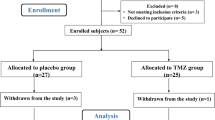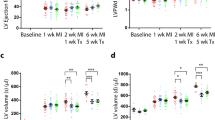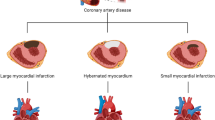Abstract
There is controversy regarding the superiority of carvedilol (C) over metoprolol (M) in congestive heart failure. We hypothesized that C is superior to M in chronic ischemic cardiomyopathy because of its better anti-inflammatory and pro-angiogenic effects. In order to test our hypothesis we used a chronic canine model of multivessel ischemic cardiomyopathy where myocardial microcatheters were placed from which interstitial fluid was collected over time to measure leukocyte count and cytokine levels. After development of left ventricular dysfunction, the animals were randomized into four groups: sham (n = 7), placebo (n = 8), M (n = 11), and C (n = 10), and followed for 3 months after treatment initiation. Tissue was examined for immunohistochemistry, oxidative stress, and capillary density. At 3 months both rest and stress wall thickening were better in C compared to the other groups. At the end of 3 months of treatment end-systolic wall stress also decreased the most in C. Similarly resting myocardial blood flow (MBF) improved the most in C as did the stress endocardial/epicardial MBF. Myocardial interstitial fluid showed greater attenuation of leukocytosis with C compared to M, which was associated with less fibrosis and oxidative stress. C also had higher IL-10 level and capillary density. In conclusion, in a chronic canine model of multivessel ischemic cardiomyopathy we found 3 months of C treatment resulted in better resting global and regional function as well as better regional function at stress compared to M. These changes were associated with higher myocardial levels of the anti-inflammatory cytokine IL-10 and less myocardial oxidative stress, leukocytosis, and fibrosis. Capillary density and MBF were almost normalized. Thus in the doses used in this study, C appears to be superior to M in a chronic canine model of ischemic cardiomyopathy from beneficial effects on inflammation and angiogenesis. Further studies are required for comparing additional doses of these drugs.




Similar content being viewed by others
References
Abbate A, Van Tassell BW, Seropian IM, Toldo S, Robati R, Varma A, Salloum FN, Smithson L, Dinarello CA (2010) Interleukin-1 modulation using a genetically engineered antibody prevents adverse cardiac remodeling following acute myocardial infarction in the mouse. Eur J Heart Fail 12:319–322. doi:10.1093/eurjhf/hfq017
Bin JP, Wei K, Pelberg RA, Coggins M, Goodman NC, Kaul S (2000) Relation between regional function and coronary blood flow reserve in multivessel coronary artery stenosis. Am J Physiol 279:H3058–H3064
Bin JP, Pelberg RA, Coggins MP, Wei K, Kaul S (2002) Mechanism of Inducible regional dysfunction during dipyridamole Stress. Circulation 106:112–117. doi:10.1161/01.CIR00000202230839005
Brandtzaeg P, Osnes L, Ovstebo R, Joo GB, Westvik AB, Kierulf P (1996) Net inflammatory capacity of human septic shock plasma evaluated by a monocyte-based target cell assay: identification of interleukin-10 as a major functional deactivator of human monocytes. J Exp Med 184:51–60. doi:10.1084/jem.184.1.51
Braunwald E, Kloner RA (1982) The stunned myocardium: prolonged, postischemic ventricular dysfunction. Circulation 66:1146–1149. doi:10.1161/01.CIR.66.6.1146
Braunwald E, Rutherford JD (1986) Reversible ischemic left ventricular dysfunction: evidence for the “hibernating myocardium”. J Am Coll Cardiol 8:1467–1470. doi:10.1016/S0735-1097(86)80325-4
Bristow MR, Adams KF, Bauman JL, Feldman AM, Giles TD, Goldstein S, Mann DL, Talbert RL (2005) The COMET trial. Congest Heart Fail 11:39–47. doi:10.1111/j.1527-5299.2005.04076.x
Camici PG, Wijns W, Borgers M, De Silva R, Ferrari J, Knuuti J, Lammerstma AA, Liedtke AJ, Paternostro G, Vatner SF (1997) Pathophysiological mechanisms of chronic reversible left ventricular dysfunction due to coronary artery disease (hibernating myocardium). Circulation 96:3205–3214. doi:10.1161/01.CIR.96.9.3205
Castro P, Vukasovic JL, Chiong M, Diaz-Araya G, Alcaino H, Copaja M, Valenzuela R, Greig D, Perez O, Corbalan R, Lavandero S (2005) Effects of carvedilol on oxidative stress and chronotropic response to exercise in patients with chronic heart failure. Eur J Heart Fail 7:1033–1039. doi:10.1016/j.ejheart.2004.11.009
Clarke CJ, Hales A, Hunt A, Foxwell BM (1998) IL-10 mediated suppression of TNF-a production is independent of its ability to inhibit NF-kB activity. Eur J Immunol 28:1719–1726. doi:10.1002/(SICI)1521-4141(199805)28:05<1719:AID-IMMU1719>3.0.CO;2-Q
Firoozan S, Wei K, Linka A, Skyba D, Goodman NC, Kaul S (1999) A canine model of chronic ischemic cardiomyopathy: characterization of regional flow-function relations. Am J Physiol 276:H446–H455
Fishbein MC, Meerbaum S, Rit J, Lando U, Kanmatsuse K, Mercier JC, Corday E, Ganz W (1981) Early phase acute myocardial infarct size quantification: validation of the triphenyl tetrazolium chloride tissue enzyme staining technique. Am Heart J 101:593–600. doi:10.1016/0002-8703(81)90226-X
Guth ND, Heusch G, Seitelberger R, Ross J Jr (1987) Mechanism of beneficial effect of beta-adrenergic blockade on exercise-induced myocardial ischemia in conscious dogs. Circ Res 60:738–746. doi:10.1161/01.RES.60.5.738
Heusch G, Schulz R, Rahimtoola H (2005) Myocardial hibernation: a delicate balance. Am J Physiol Heart Circ Physiol 288:H984–H999. doi:10.1152/ajpheart.01109.2004
Heusch G (2013) The regional myocardial flow-function relationship: a framework for an understanding of acute ischemia, hibernation, stunning and coronary microembolization. Circ Res 112:1535–1537. doi:10.1161/CIRCRESAHA.113.301446
Heymann MA, Payne BD, Hoffman JI, Rudolph AM (1997) Blood flow measurements with radio-nuclide labeled particles. Prog Cardiovasc Dis 20:52–79. doi:10.1016/S0033-0620(77)80005-4
Lalani I, Bhoi K, Ahmed AF (1979) Interleukin-10: biology, role in inflammation and autoimmunity. Ann Allergy 79:469–483. doi:10.1016/S1081-1206(10)63052-9
Le DE, Pelberg RA, Leong-Poi H, Bin JP, Linden J, Kaul S (2003) A1-receptor blockade: a novel approach for assessing myocardial viability in chronic ischemic cardiomyopathy. J Am Soc Echocardiogr 16:764–769. doi:10.1016/S0894-7317(03)00214-1
Le DE, Powers ER, Bin JP, Leong-Poi H, Goodman NC, Kaul S (2007) Transmyocardial revascularization ameliorates Ischemia by reversing paradoxical catecholamine-induced vasoconstriction. J Nucl Cardiol 14:207–214. doi:10.1016/j.nuclcard.2006.12.328
Li B, Liao YH, Cheng X, Ge H, Guo H, Wang M (2006) Effects of carvedilol on cardiac cytokines expression and remodeling in rat with acute myocardial infarction. Int J Cardiol 111:247–255. doi:10.1016/j.ijcard.2005.08.065
Libby P, Maroko PR, Covell JW, Malloch CI, Ross J Jr, Braunwald E (1973) Effect of practolol on the extent of myocardial ischaemic injury after experimental coronary occlusion and its effect on ventricular function in the normal and ischaemic heart. Cardiovasc Res 7:167–173. doi:10.1093/cvr/7.2.167
Maack C, Elter T, Nickenig G, LaRosee K, Crivaro M, Stäblein A, Wuttke H, Böhm M (2001) Prospective crossover comparison of carvedilol and metoprolol in patients with chronic heart failure. J Am Coll Cardiol 38:939–946. doi:10.1016/S0735-1097(01)01471-1
Mann DL (2002) Inflammatory mediators and the failing heart: past, present, and the foreseeable future. Circ Res 91:988–998. doi:10.1161/01.RES.0000043825.01705.1B
Matsuzaki M, Patritti J, Tajimi T, Miller M, Kemper WS, Ross J (1984) Effects of beta-blockade on regional myocardial blood flow and function during exercise. Am J Physiol 247:H52–H60
McBride BF, White CM (2005) Critical differences among beta-adrenoreceptor antagonists in myocardial failure: debating the MERIT of COMET. J Clin Pharmacol 45:6–24. doi:10.1177/0091270004269841
McTiernan CF, Lemster BH, Frye C, Brooks S, Combes A, Feldman AM, Charles F (1997) Interleukin-1β inhibits phospholamban gene expression in cultured cardiomyocytes. Circ Res 81:493–503. doi:10.1161/01.RES.81.4.493
MERIT-HF Study Group (1999) Effect of metoprolol CR/XL in chronic heart failure: metoprolol CR/XL randomised intervention trial in-congestive heart failure (MERIT-HF). Lancet 353:2001–2007. doi:10.1016/S0140-6736(99)04440-2
Molenaar P, Christ T, Ravens U, Kaumann A (2006) Carvedilol blocks beta2- more than beta1-adrenoceptors in human heart. Cardiovas Res 69:128–139. doi:10.1016/j.cardiores.2005.08.024
Moore K, Roberts LJ (1998) Measurement of lipid peroxidation. Free Radic Res 28:659–671. doi:10.3109/10715769809065821
Oh BH, Ono S, Gilpin E, Ross J (1993) Altered left ventricular remodeling with beta-adrenergic blockade and exercise after coronary reperfusion in rats. Circulation 87:608–616. doi:10.1111/j.1540-8191.1996.tb00073.x
Okafor CC, Perreault-Micale C, Hajjar RJ, Lebeche D, Skiroman K, Jabbour G, Doye AA, Lee MX, Laste N, Gwathmey JK (2003) Chronic treatment with carvedilol improves ventricular function and reduces myocyte apoptosis in an animal model of heart failure. BMC Physiol 3:1–9. doi:10.1186/1472-6793-3-6
Oldroyd KG, Chopra M, Rankin AC, Belch JJF, Cobbe SM (1990) Lipid peroxidation during myocardial ischaemia induced by pacing. Br Heart J 63:88–92. doi:10.1136/hrt.63.2.88
Packer M, Bristow MR, Cohn JN, Colucci WS, Fowler MB, Gilbert EM, Shusterman NH (1996) The effect of carvedilol on morbidity and mortality in patients with chronic heart failure. N Engl J Med 334:1349–1355. doi:10.1056/NEJM199605233342101
Pelberg RA, Spotnitz WD, Bin J-P, Le E, Goodman NC, Kaul S (2001) Mechanism of myocardial dysfunction in the presence of chronic coronary stenosis and normal resting myocardial blood flow: clinical implications. J Am Soc Echocardiogr 14:1047–1056. doi:10.1067/mje.2001.113232
Polidori MC, Savino K, Alunni G, Freddio M, Senin U, Sies H, Stahl W, Mecocci P (2002) Plasma lipophilic antioxidants and malondialhehyde in congestive heart failure patients: relationship to disease severity. Free Radic Biol Med 32:148–152
Poole-Wilson PA, Swedberg K, Cleland JGF, Di Lenarda A, Hanrath P, Komajda M, Lubsen J, Lutiger B, Metra M, Remme WJ, Torp-Pedersen C, Scherhag A, Skene A, For the COMET Investigators (2003) Comparison of carvedilol and metoprolol on clinical outcomes in patients with chronic heart failure in the carvedilol or metoprolol European trial (COMET): randomized controlled trial. Lancet 362:7–13. doi:10.1016/S0140-6736(03)13800-7
Prabhu SD, Chandrasekar B, Murray DR, Freeman GL (2000) β-Adrenergic blockade in developing Heart failure. Effects on myocardial inflammatory cytokines, nitric oxide, and remodeling. Circulation 101:2103–2109. doi:10.1161/01.CIR.101.17.2103
Radovanovic S, Savic-Radojevic A, Pljesa-Ercegovac M, Djukic T, Suvakov S, Krotin M, Simic DY, Matic M, Radojicic Z, Pekmezovic T, Simic T (2012) Markers of oxidative damage and antioxidant enzyme activities as predictors of morbidity and mortality in patients with chronic heart failure. J Card Fail 18:493–501. doi:10.1016/j.cardfail.2012.04.003
Rowland DG (1994) Gutgesell HP (1994) Use of mean arterial pressure for noninvasive determination of left ventricular end-systolic wall stress in infants and children. Amer J Cardiol 74:98–99
Ruwald MH, Ruwald AH, Jons C, Alexis A, McNitts S, Zareba W, Moss AJ (2013) Effect of metoprolol versus carvedilol on outcomes in MADIT-CRT (multicenter automatic defibrillator implantation trial with cardiac resynchronization therapy. J Am Coll Cardiol 61:1518–1526
Siwik DA, Chang DL, Colucci WS (2000) Interleukin-1β and tumor necrosis factor-a decrease collagen synthesis and increase matrix metalloproteinase activity in cardiac fibroblasts in vitro. Circ Res 86:1259–1265. doi:10.1161/01.RES.86.12.1259
Sklenar J, Jayaweera AR, Kaul S (1992) A computer-aided approach for the quantification of regional left ventricular function using two-dimensional echocardiography. J Am Soc Echocardiogr 5:33–40
Yasunari K, Maeda K, Nakamura M, Yoshikawa J (2002) Carvedilol inhibits pressure-induced increase in oxidative stress in coronary smooth muscle cells. Hypertens Res 25:419–425
Acknowledgments
The authors would like to thank Craig Goodman, B.S. for his expert technical assistance with the experiments. We are also grateful to Melissa Bevard, Helen Liu, and Yan Zhao for their assistance with the histology and immunohistochemistry work and to Jay Phillips, Robert Webber, Lisa Bleyle and Dennis Koop from the Bioanalytical Shared Resource/Pharmacokinetics Core University Shared Resources at OHSU for their assistance with the oxidative stress assessment.
Supported in part by grants from the National Institutes of Health (K-08-HL0742901, D. Elizabeth Le and R01-HL660346, Sanjiv Kaul). The radiolabeled microspheres were provided by Dupont Pharmaceuticals, North Billerica, MA, and the ultrasound equipment was supplied by Philips Ultrasound, Andover, MA.
Conflicts of interest
None.
Author information
Authors and Affiliations
Corresponding author
Rights and permissions
About this article
Cite this article
Le, D.E., Pascotto, M., Leong-Poi, H. et al. Anti-inflammatory and pro-angiogenic effects of beta blockers in a canine model of chronic ischemic cardiomyopathy: comparison between carvedilol and metoprolol. Basic Res Cardiol 108, 384 (2013). https://doi.org/10.1007/s00395-013-0384-7
Received:
Revised:
Accepted:
Published:
DOI: https://doi.org/10.1007/s00395-013-0384-7




